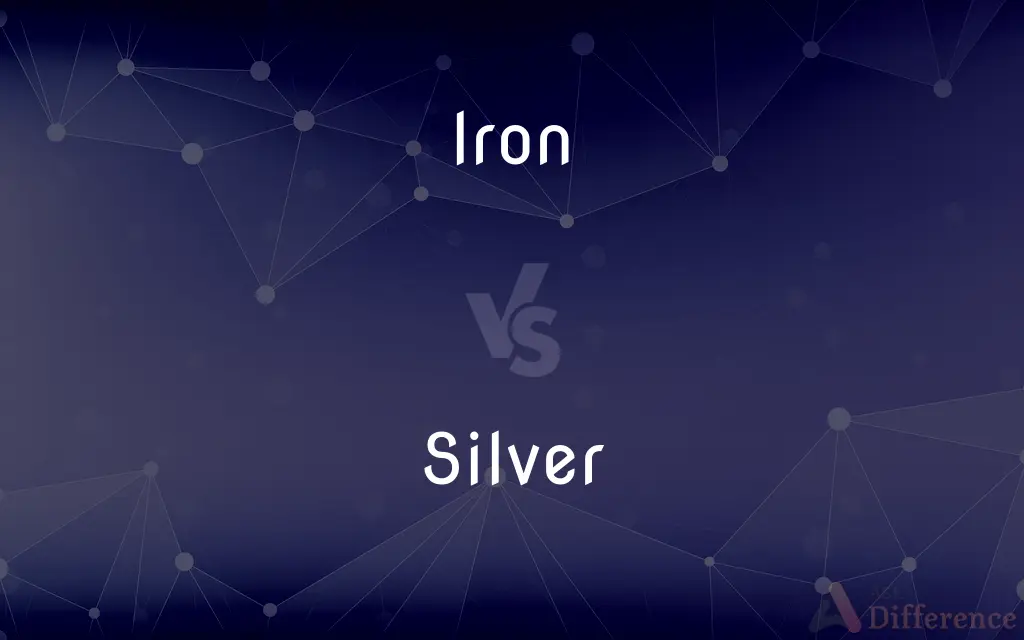Iron vs. Silver — What's the Difference?
Edited by Tayyaba Rehman — By Maham Liaqat — Updated on April 15, 2024
Iron is a common, strong metal used in construction and manufacturing, whereas silver is a precious metal valued for its conductivity and decorative appeal.

Difference Between Iron and Silver
Table of Contents
ADVERTISEMENT
Key Differences
Iron is primarily known for its strength and durability, making it essential in construction and machinery manufacturing. On the other hand, silver is softer and more malleable, which makes it ideal for crafting jewelry and decorative items.
Iron oxidizes or rusts when exposed to moisture, leading to corrosion that can weaken it over time. Whereas, silver tarnishes when exposed to air and sulfur, but this does not structurally weaken the metal.
From an economic standpoint, iron is more abundant and therefore less expensive than silver, which is considered a precious metal and holds significant monetary value.
In terms of electrical conductivity, silver is the best conductor among all metals; however, iron's conductivity is much lower, making it unsuitable for applications where superior conductivity is required.
Comparison Chart
Common Uses
Construction, machinery
Jewelry, electronics
ADVERTISEMENT
Mechanical Strength
High
Lower than iron
Conductivity
Low electrical conductivity
High electrical conductivity
Economic Value
Less expensive, more abundant
Expensive, less abundant
Chemical Properties
Prone to rusting
Prone to tarnishing
Compare with Definitions
Iron
A metal element, magnetic, commonly used in steel production.
The bridge is reinforced with iron beams.
Silver
To coat something with a silver substance.
The mirror was silvered to create a reflective surface.
Iron
To smooth clothes using a heated tool.
She prefers to iron her shirts to perfection.
Silver
A precious metal with high thermal and electrical conductivity.
The necklace is made of sterling silver.
Iron
A dietary mineral essential for oxygen transport in blood.
Spinach is a good source of iron.
Silver
Referring to a 25th anniversary.
They celebrated their silver anniversary with a party.
Iron
Showing great strength or resilience.
The team displayed an iron determination to win.
Silver
A symbol of wealth and quality.
Their family was born with a silver spoon in their mouths.
Iron
A golf club with a metal head.
He chose a seven iron for the short approach shot.
Silver
A light grayish-white color.
The artist used silver paint for the clouds in the mural.
Iron
An implement made of iron alloy or similar metal, especially a bar heated for use in branding, curling hair, or cauterizing.
Silver
Silver is a chemical element with the symbol Ag (from the Latin argentum, derived from the Proto-Indo-European h₂erǵ: "shiny" or "white") and atomic number 47. A soft, white, lustrous transition metal, it exhibits the highest electrical conductivity, thermal conductivity, and reflectivity of any metal.
Iron
Iron () is a chemical element with symbol Fe (from Latin: ferrum) and atomic number 26. It is a metal that belongs to the first transition series and group 8 of the periodic table.
Silver
Symbol Ag A lustrous white, ductile, malleable metallic element, occurring both uncombined and in ores such as argentite, having the highest thermal and electrical conductivity of the metals. It is highly valued for jewelry, tableware, and other ornamental use and is widely used in coinage, photography, dental and soldering alloys, electrical contacts, and printed circuits. Atomic number 47; atomic weight 107.868; melting point 961.78°C; boiling point 2,162°C; specific gravity 10.50 (20°C); valence 1, 2. See Periodic Table.
Iron
Symbol Fe A silvery-white, lustrous, malleable, ductile, magnetic or magnetizable, metallic element occurring abundantly in combined forms, notably in hematite, limonite, magnetite, and taconite, and used alloyed in a wide range of important structural materials. Atomic number 26; atomic weight 55.845; melting point 1,538°C; boiling point 2,861°C; specific gravity 7.874 (at 20°C); valence 2, 3, 4, 6. See Periodic Table.
Silver
This metallic element as a commodity or medium of exchange.
Iron
Great hardness or strength; firmness
A will of iron.
Silver
Coins made of this metallic element.
Iron
(Sports) Any of a series of golf clubs having a bladelike metal head and numbered from one to nine in order of increasing loft.
Silver
A medal made of silver awarded to one placing second in a competition, as in the Olympics.
Iron
A metal appliance with a handle and a weighted flat bottom, used when heated to press wrinkles from fabric.
Silver
Domestic articles, such as tableware, made of or plated with silver.
Iron
A harpoon.
Silver
Tableware, especially eating and serving utensils, made of steel or another metal.
Iron
Irons Fetters; shackles.
Silver
A lustrous medium gray.
Iron
A tonic, pill, or other medication containing iron and taken as a dietary supplement.
Silver
A silver salt, especially silver nitrate, used to sensitize paper.
Iron
Made of or containing iron
Iron bars.
An iron alloy.
Silver
Made of or containing silver
A silver bowl.
Silver ore.
Iron
Strong, healthy, and capable of great endurance
An iron constitution.
Silver
Resembling silver, especially in having a lustrous shine; silvery.
Iron
Inflexible; unyielding
Iron resolve.
Silver
Of a lustrous medium gray
Silver hair.
Iron
Holding tightly; very firm
Has an iron grip.
Silver
Having a soft, clear, resonant sound.
Iron
To press and smooth with a heated iron
Iron clothes.
Silver
Eloquent; persuasive
A silver voice.
Iron
To remove (creases) by pressing.
Silver
Favoring the adoption of silver as a standard of currency
The silver plank of the 1896 Democratic platform.
Iron
To put into irons; fetter.
Silver
Of or constituting a 25th anniversary.
Iron
To fit or clad with iron.
Silver
To cover, plate, or adorn with silver or a similar lustrous substance.
Iron
To iron clothes.
Silver
To give a silver color to.
Iron
(uncountable) A common, inexpensive metal, silvery grey when untarnished, that rusts, is attracted by magnets, and is used in making steel.
Silver
To coat (photographic paper) with a film of silver nitrate or other silver salt.
Iron
A metallic chemical element having atomic number 26 and symbol Fe.
Silver
To become silvery.
Iron
Any material, not a steel, predominantly made of elemental iron.
Wrought iron, ductile iron, cast iron, pig iron, gray iron
Silver
(uncountable) A lustrous, white, metallic element, atomic number 47, atomic weight 107.87, symbol Ag.
Iron
(countable) A tool or appliance made of metal, which is heated and then used to transfer heat to something else; most often a thick piece of metal fitted with a handle and having a flat, roughly triangular bottom, which is heated and used to press wrinkles from clothing, and now usually containing an electrical heating apparatus.
Silver
Coins made from silver or any similar white metal.
Iron
(usually plural, irons) shackles.
Silver
Cutlery and other eating utensils, whether silver or made from some other white metal.
Iron
(slang) A firearm, either a long gun or a handgun.
Silver
Any items made from silver or any other white metal.
Iron
(uncountable) A dark shade of the color silver.
Silver
(uncountable) A shiny gray color.
Iron
(golf) A golf club used for middle-distance shots.
Silver
(countable) a silver medal
Iron
Used as a symbol of great strength or toughness, or to signify a very strong or tough material.
A will of iron
He appeared easygoing, but inside he was pure iron.
Silver
Anything resembling silver; something shiny and white.
Iron
(weightlifting) Weight used as resistance for the purpose of strength training.
He lifts iron on the weekends.
Silver
Made from silver.
Iron
A meteorite consisting primarily of metallic iron (mixed with a small amount of nickel), as opposed to one composed mainly of stony material.
Irons and stony irons can be much larger than stony meteorites and are much more visually striking, but make up only a few percent of all meteorites.
Silver
Made from another white metal.
Iron
A safety curtain in a theatre.
Silver
Having a color like silver: a shiny gray.
Iron
Dumb bombs, those without guidance systems.
Silver
Denoting the twenty-fifth anniversary, especially of a wedding.
Iron
(not comparable) Made of the metal iron.
Silver
(of commercial services) Premium, but inferior to gold.
Iron
(figuratively) Strong as of will, inflexible.
She had an iron will.
He held on with an iron grip.
An iron constitution
Iron men
Silver
Having the clear, musical tone of silver; soft and clear in sound.
A silver-voiced young girl
Iron
(transitive) To pass an iron over (clothing or some other item made of cloth) in order to remove creases.
Silver
To acquire a silvery colour.
Iron
To shackle with irons; to fetter or handcuff.
Silver
To cover with silver, or with a silvery metal.
To silver a pin; to silver a glass mirror plate with an amalgam of tin and mercury
Iron
(transitive) To furnish or arm with iron.
To iron a wagon
Silver
To polish like silver; to impart a brightness to, like that of silver.
Iron
The most common and most useful metallic element, being of almost universal occurrence, usually in the form of an oxide (as hematite, magnetite, etc.), or a hydrous oxide (as limonite, turgite, etc.). It is reduced on an enormous scale in three principal forms; viz., cast iron, steel, and wrought iron. Iron usually appears dark brown, from oxidation or impurity, but when pure, or on a fresh surface, is a gray or white metal. It is easily oxidized (rusted) by moisture, and is attacked by many corrosive agents. Symbol Fe (Latin Ferrum). Atomic number 26, atomic weight 55.847. Specific gravity, pure iron, 7.86; cast iron, 7.1. In magnetic properties, it is superior to all other substances.
Silver
To make hoary, or white, like silver.
Iron
An instrument or utensil made of iron; - chiefly in composition; as, a flatiron, a smoothing iron, etc.
My young soldier, put up your iron.
Silver
A soft white metallic element, sonorous, ductile, very malleable, and capable of a high degree of polish. It is found native, and also combined with sulphur, arsenic, antimony, chlorine, etc., in the minerals argentite, proustite, pyrargyrite, ceragyrite, etc. Silver is one of the "noble" metals, so-called, not being easily oxidized, and is used for coin, jewelry, plate, and a great variety of articles. Symbol Ag (Argentum). Atomic weight 107.7. Specific gravity 10.5.
Iron
Fetters; chains; handcuffs; manacles.
Four of the sufferers were left to rot in irons.
Silver
Coin made of silver; silver money.
Iron
Strength; power; firmness; inflexibility; as, to rule with a rod of iron.
Silver
Anything having the luster or appearance of silver.
Iron
An iron-headed club with a deep face, chiefly used in making approaches, lifting a ball over hazards, etc.
Silver
The color of silver.
Iron
Of, or made of iron; consisting of iron; as, an iron bar, dust.
Silver
Of or pertaining to silver; made of silver; as, silver leaf; a silver cup.
Iron
Resembling iron in color; as, iron blackness.
Silver
Precious; costly.
Iron
Like iron in hardness, strength, impenetrability, power of endurance, insensibility, etc.;
Silver
To cover with silver; to give a silvery appearance to by applying a metal of a silvery color; as, to silver a pin; to silver a glass mirror plate with an amalgam of tin and mercury.
Iron
Rude; hard; harsh; severe.
Iron years of wars and dangers.
Jove crushed the nations with an iron rod.
Silver
To polish like silver; to impart a brightness to, like that of silver.
And smiling calmness silvered o'er the deep.
Iron
Firm; robust; enduring; as, an iron constitution.
Silver
To make hoary, or white, like silver.
His head was silvered o'er with age.
Iron
Inflexible; unrelenting; as, an iron will.
Silver
To acquire a silvery color.
The eastern sky began to silver and shine.
Iron
Not to be broken; holding or binding fast; tenacious.
Silver
A soft white precious univalent metallic element having the highest electrical and thermal conductivity of any metal; occurs in argentite and in free form; used in coins and jewelry and tableware and photography
Iron
To smooth with an instrument of iron; especially, to smooth, as cloth, with a heated flatiron; - sometimes used with out.
Silver
Coins made of silver
Iron
To shackle with irons; to fetter or handcuff.
Silver
A light shade of gray
Iron
To furnish or arm with iron; as, to iron a wagon.
Silver
Silverware eating utensils
Iron
A golf club that has a relatively narrow metal head
Silver
A medal made of silver (or having the appearance of silver) that is usually awarded for winning second place in a competition
Iron
Metal shackles; for hands or legs
Silver
Coat with a layer of silver or a silver amalgam;
Silver the necklace
Iron
Implement used to brand live stock
Silver
Make silver in color;
Her worries had silvered her hair
Iron
Home appliance consisting of a flat metal base that is heated and used to smooth cloth
Silver
Turn silver;
The man's hair silvered very attractively
Iron
Press and smooth with a heated iron;
Press your shirts
Silver
Made from or largely consisting of silver;
Silver bracelets
Iron
Extremely robust;
An iron constitution
Silver
Having the white lustrous sheen of silver;
A land of silver (or silvern) rivers where the salmon leap
Repeated scrubbings have given the wood a silvery sheen
Silver
Lustrous gray; covered with or tinged with the color of silver;
Silvery hair
Silver
Expressing yourself readily, clearly, effectively;
Able to dazzle with his facile tongue
Silver speech
Common Curiosities
Why does iron rust but silver tarnish?
Iron reacts with oxygen and water causing rust, while silver reacts with sulfur compounds in the air causing tarnish.
Which is more expensive, iron or silver?
Silver is generally more expensive than iron due to its rarity and status as a precious metal.
What are the main uses of iron and silver?
Iron is mainly used in construction and industrial applications, whereas silver is used in jewelry, electronics, and decorative items.
What are the electrical properties of iron compared to silver?
Silver is the best conductor of electricity among all metals, while iron has significantly lower conductivity.
Can both iron and silver be found in food?
Iron is commonly found in foods and is essential for health, but silver is not typically found in the diet.
Can iron and silver be recycled?
Both iron and silver are highly recyclable, with recycling being a key component in managing their supplies and reducing environmental impact.
What role does iron play in biology compared to silver?
Iron is crucial for biological processes in almost all living organisms, particularly in oxygen transport in mammals, whereas silver is used mainly for its antimicrobial properties in medical applications.
Is iron or silver more abundant on Earth?
Iron is far more abundant than silver, making up about 5% of the Earth’s crust, compared to silver's much rarer presence.
How are the chemical properties of iron and silver utilized in industries?
Iron's ability to form various alloys makes it versatile for construction and manufacturing, while silver's antibacterial properties and conductivity make it valuable in medical and electronic fields.
How do the melting points of iron and silver compare?
Iron has a higher melting point (1538°C) compared to silver (961.8°C), reflecting their different uses and properties in various applications.
What are the physical properties that differentiate iron from silver?
Iron is hard and can be magnetized, while silver is softer, shinier, and has the highest thermal and electrical conductivity of any metal.
What environmental impacts do the mining of iron and silver have?
Both metals impact the environment; iron ore mining disrupts landscapes and produces waste rock and pollution, while silver mining can lead to significant water pollution and toxic waste.
What historical uses did iron and silver have?
Historically, iron has been used for weapons and tools dating back thousands of years, while silver has been used as currency and for high-status objects like jewelry and utensils.
How do market fluctuations affect the value of iron compared to silver?
The value of iron generally fluctuates with industrial demand, while silver prices can be more volatile, influenced by both industrial demand and investment or speculative interests.
How are iron and silver extracted from their ores?
Iron is typically extracted from iron ore in a blast furnace, while silver is extracted from ore through a process of crushing, grinding, flotation, and smelting.
Share Your Discovery

Previous Comparison
Fortis vs. Lenis
Next Comparison
Cashpoint vs. AtmAuthor Spotlight
Written by
Maham LiaqatEdited by
Tayyaba RehmanTayyaba Rehman is a distinguished writer, currently serving as a primary contributor to askdifference.com. As a researcher in semantics and etymology, Tayyaba's passion for the complexity of languages and their distinctions has found a perfect home on the platform. Tayyaba delves into the intricacies of language, distinguishing between commonly confused words and phrases, thereby providing clarity for readers worldwide.
















































